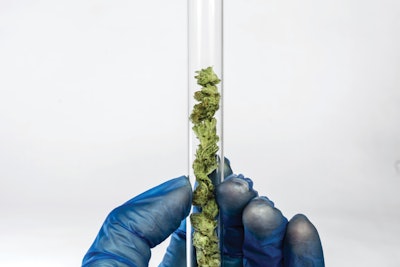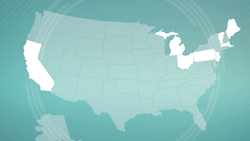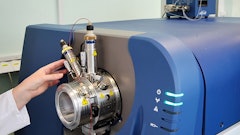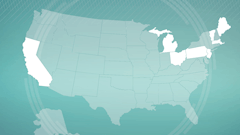
Everyone with serious cannabis industry experience has spoken with patients, friends and relatives about cannabis’s effectiveness as medicine. Patients tend to be the most familiar with its effectiveness in controlling disease symptoms, including pain, and in controlling various diseases themselves. We all find ourselves with a chance to educate when an outsider asks, “It’s not only for pain, but it actually treats the disease?”
Some of us may dive into technical details and explain that THC and CBD are partial agonists for the endocannabinoid system’s CB1 and CB2 receptors, among other things. We also may discuss cannabinoid-induced apoptosis (cellular suicide activated by the presence or removal of a stimulus) among malignant cells. In response, we often receive blank stares.
Obviously, it would be nice if patients had these conversations with doctors before turning to cannabis-industry members. Doctors’ ignorance of the endocannabinoid system and reticence to engage with our industry keeps them from jumping in. We’ve talked to a few, who fell into the following categories.
- Prehistoric medical training: Many medical school professors, and the doctors those professors trained, completed their respective educations before the early ’90s, prior to the discovery of the human endocannabinoid system. Those doctors typically do not know that the endocannabinoid system exists.
- Conventional medicine: Many doctors live quite well working within established medical practice care standards (defined treatment protocols for each disease state) and insurance-driven drug formularies (lists of drug products covered by each source of insurance). In addition, federal resistance in Congress, the Food and Drug Administration (FDA), the National Institute on Drug Abuse (NIDA) and the Drug Enforcement Administration (DEA) has effectively prohibited the randomized, double-blind, placebo- controlled clinical research that has otherwise served the medical community reasonably well. Thus, many doctors find it unreasonable to risk their licenses to practice by involving themselves or their patients in unproven medicine.
For the doctors who fall into those buckets, medical marijuana is, at best, an unproven novelty. There are, however, three other groups to consider. Each of these three groups accepts the thought that marijuana may be extremely effective in treating various disease states:
- Yes, but not in my practice: This first group understands at least some of the science behind medical marijuana, but is not willing to accept any risk from cannabis involvement. This group refers its patients to doctors with recognized medical marijuana expertise.
- Cannabis mills: The next group of doctors receives payment for registering patients with their respective state regulators. Nothing more, nothing less. Some are principled, and some are not.
- The few good ones: Finally, there are a few doctors who are both knowledgeable and involved. Even when they start with little or no awareness of medical marijuana, given a patient with an unresolved need, these doctors follow their professional responsibilities wherever they may lead. Most professions have some great professionals; medicine is no different.
Can We Help the Situation?
Doctors have spent long hours and long years with biology and chemistry texts and in laboratories, all focused on human health. As a group, our focus is typically elsewhere. Some of the issues for these doctors might originate from how we present ourselves to them, like being heavily focused on the recreational market or on our businesses’ bottom lines.
If we wanted to make a serious attempt to engage doctors, how might we do this, and what might be in it for us?
The cannabis market can learn several lessons from the American consumer packaged goods industry, including:
Identification: We would need to accept some basic assumptions about products in the United States to understand how we might engage doctors with our industry. U.S. law requires that all producers identify their products to a level of detail that is unfamiliar to our industry. “Wild-caught” is different from “farmed;” “wild” is different from “organic,” which is different from “all-natural.” In the U.S., ingredient lists are simply givens on product packaging. We take for granted the testing and the labeling that comes with nutritional content. While all of this is not relevant to cannabis products, some of it may be. Although state labeling regulations that govern cannabis labels may be demanding, all other packaged goods producers in America face rather challenging labeling demands.
Safety: Americans do not expect contaminants of any kind in any of their products, and doctors expect recreational products (candy, baked goods and beer) to meet the same standards. Although the war on drugs left many of us disgusted with the government, the end of that war does not mean that cannabis products are exempt from meeting standards, or that we are immune from the product liability lawsuits for which our legal system is world-famous.
Would working with doctors mean full testing protocols for every batch, everywhere? Probably not. Chocolate bars, ice cream and beer are not tested for medical impact. Much of our product belongs to the same “recreational” classification. For this type of product, we should expect to be held accountable on matters such as identification, purity, safety and adult-oriented marketing and packaging.
Pharmaceutical effect: For products intended to address medical symptoms (including pain) or to treat medical diseases, we should expect more accountability. At least initially, doctors would look for third-party assurance as to the most medically significant components of our products. Based on the consistency of our results, over time, we might push to move that testing from independent labs into our operations.
Becoming engaged with the American medical establishment, particularly with doctors, will be complicated and expensive. It will devour time and money. Why might we consider moving in this direction?
The Great Prize
General access to the American market with legitimate recreational or medical products is a good enough answer for us. This American market, by all measures the largest in the world, with a single language, a single currency and—perhaps eventually—a single set of standards, presents to all of us the possibility to do well by doing good. The opportunities in our new industry are the world’s envy, and many international players are attempting to work their way in.
The least legitimate recreational and medical players will likely get knocked out. Some will not keep up with American consumer demands. Others, for better or for worse, will fall to lawsuits or regulatory enforcement. For those of us willing to deal with the market demands, including the needs of its doctors, the business opportunities will be meaningful.
Active ingredients: Single Molecules vs. Whole-Plant Compounds
Exploring and developing the concept of whole-plant extracts, as opposed to the FDA’s conventionally single-molecule approach, will require a lot of time and attention.
Historically, the FDA cleared out snake oil salesmen and other frauds from the American pharmaceutical market by demanding that formulators identify each pharmaceutical product’s active ingredient, which has typically been a single chemical compound. In what we can see as an inadvertent step in our direction, the FDA has recognized pharmaceutical biologics, but there is a great distance between a monoclonal antibody (a type of protein made in the laboratory that can bind to substances in the body, including cancer cells, according to Cancer.gov) and a cannabis medication with hundreds of cannabinoids, terpenoids and potentially other compounds that may be exerting a therapeutic entourage effect.
FDA regulations that govern the production and sale of nutritional supplements offer another potential, but rather imperfect path through the FDA gauntlet. Nevertheless, we will argue that 50 years of federal suppression of meaningful research on cannabinoids cannot be ignored. Until we have the time to explore the synergies of the multiple compounds within cannabis, we should not be prevented from considering the value of a whole-plant approach to medicine.
Working with doctors to treat symptoms and diseases will mean much more work. We will need to persuade many skeptical clinicians that prohibition was bad and led to avoidable suffering. We will also, in turn, accept the FDA’s successes, for example, in keeping the thalidomide disaster (thousands of European children born without limbs or with severe deformities) out of America. We will also work with fractions of cannabis that more closely approximate the FDA’s current concept of medicine, as isolating cannabinoids is already becoming a common practice in the industry. We will work with doctors to make up for time lost due to the war on drugs, with accelerated testing protocols yet to be negotiated.
The doctors willing to work with us are out there, as are the patients with needs that we can help address. We have good reason to take responsibility for communicating with more of them.























